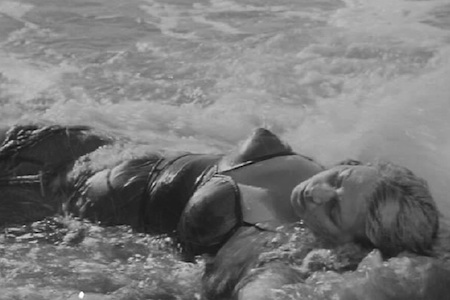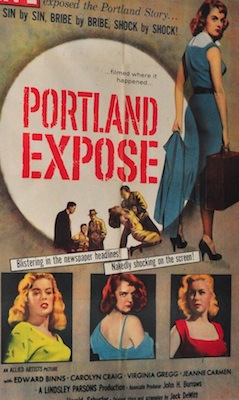The 1957 noir Portland Exposé is one of those kitschy classics that we film lovers adore viewing as a cheeky glimpse into a bygone era. All the hallmarks are there: the family man with the virginal daughter, doting wife and “gee whiz” son; the ring-a-ding dialogue filled with references to b-girls, dipsos and hopheads; and enough cigarette smoke floating around to give your TV screen nicotine stains.The film is especially fun for Portland residents like myself, as we point out the landmarks in the film that are still standing. In the opening montage alone, you can catch a glimpse of the Hotel Mallory (now the Hotel DeLuxe), the famous rose gardens in Washington Park, and the First Presbyterian Church. And throughout the film are scattered other landmarks like Union Station (the city’s Amtrak/Greyhound depot), the Portland Towers apartments and the Steel Bridge.There’s a charm, too, in seeing my hometown depicted as a post-World War II Mos Eisley with the scum and villainy coming at the hands of Union thugs looking to maintain a monopoly on (of all things) slot machines and pinball. With their influence on the bar owners of the city, the racketeers could start moving into other areas like prostitution and drugs. For folks living in the current Portland, a city whose progressive ways are sent up so lovingly in Portlandia, the movie can easily just be tucked away as a quaint throwback.Dig a little bit deeper into the history of this film, however, and you’ll find that all its cautionary and provocative aims were actually coming from real life. It’s right there on the poster for the film: “LIFE exposed the Portland Story…SIN by SIN, BRIBE by BRIBE, SHOCK by SHOCK!” Sure enough, in the March 11, 1957 issue of the newsweekly is an article entitled “Senators Hear Tales Of Scandal,” that centers what is known as the McClellan Committee, an investigation in Congress into “‘improper activities by high-ranking members of the International Brotherhood of Teamsters.”In a nutshell, the union was working to create a monopoly on the use of pinball and slot machines in Portland bars and taverns, while also setting up brothels and using their money and influence to lean on policemen and the District Attorney’s office to allow them to get away with it all. Eventually, with the help of two stalwart reporters from the Oregonian, one of the men involved, lifelong criminal and racketeer James Elkins, agreed to capture his dealings with the Teamsters via a tape recorder he kept hidden under his arm. Elkins became the key witness in the McClennan Committee hearings and helped blow open the corruption that was eating away at the Rose City.
Of course, a perfectly salacious story like that couldn’t avoid Hollywood’s grasp for long. Soon after the publication of the article, Allied Pictures tossed together a script using the LIFE story as its basis and set about filming it in the city where it all happened!The script by Jack DeWitt does crib many of the details from the true story, the tape recorder under the arm, a matronly madam who arrives to try and organize the city’s prostitution activities, but twists it so the main character is George Madison (played by Edward Binns), a put-upon family man forced to do the bidding of the criminals before working with police and attorneys.DeWitt holds to some fairly standard tropes within the framing of this story, too. Madison is shown as a solid family man trying to scrape by running a bar/restaurant just outside of Portland. After installing a couple of pinball machines from a local distributor, thugs from the organization trying to create a criminal empire threaten to scar his young daughter with acid if he doesn’t play ball. He assents, and spends the rest of the first act struggling with the success of his establishment and his moral code.That’s when the gloves really come off, including some harrowing bits of violence, particularly a nasty assault that one of the thugs (played with disturbing sleaze by future Batman co-star Frank Gorshin) attempts on Madison’s daughter, and an injection of raw sexual energy in the form of Iris, a “b-girl” played with lascivious pride by former pin-up girl Jeanne Carmen who tries to seduce Madison.Again, the whole affair seems tame by today’s standards, but the subject matter and the source material was controversial enough to almost scuttle filming entirely. According to University of Nebraska-Lincoln film professor Wheeler Dixon, the script so upset some members of the Teamsters who “took a real dislike to the film’s depiction of labor’s complicity in the rackets” that the crew for Portland Exposé had to rent cameras and lights in Hollywood and secretly ship them into the city using non-union trucks.A far cry from the welcoming attitude the TV & Film Commission now has, encouraging the folks who make Grimm and Leverage to use every inch of the city, and enjoying the gentle ribbing the town gets via Fred Armisen and Carrie Brownstein’s arch perspectives. And it’s far beyond the spacious wilderness depicted in one of the first major films to be made in Oregon, 1952’s Bend of the River.But for all the idyllic views of the skyline with Mount Hood residing in the background—a shot that opens and closes the film—Portland Exposé continues to provide a stark look at the city as it once was: a troubled burg struggling with its internal sins.





